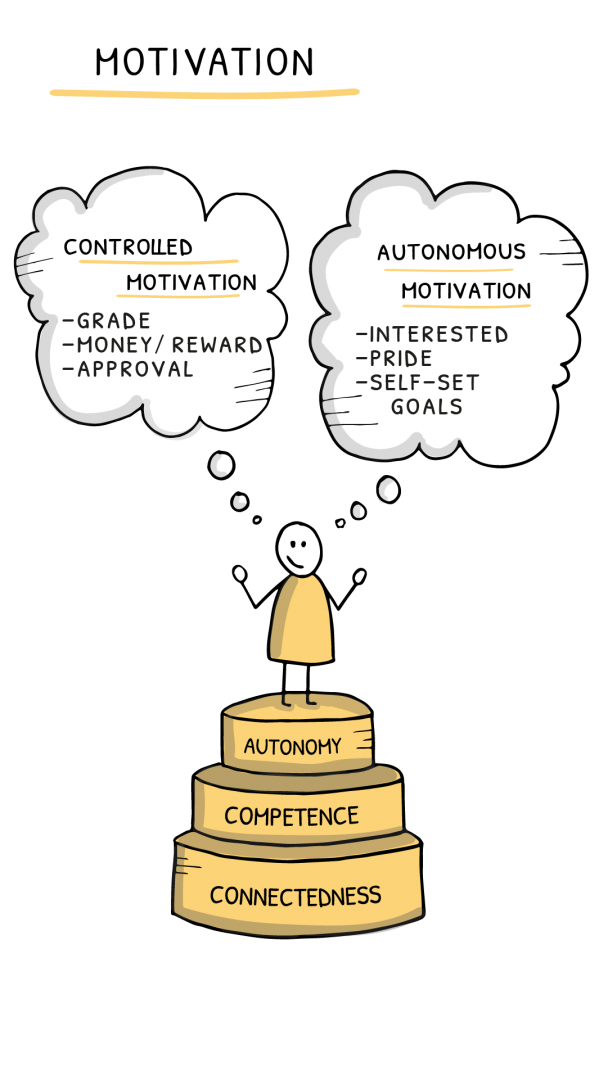Motivation
Every lecturer has asked themselves at one time or another: how do I ensure my students are motivated? Is it in my power to do so at all?
Why?
When students are motivated, they experience greater well-being and are more satisfied about their studies. They want to be active and they want to learn. Intrinsic motivation is related in part to the lecturer’s attitude and the atmosphere in the classroom. By creating the right learning environment, you have a direct influence on your students’ motivation. You can use various learning activities to enhance it.
What?
The word ‘motivation’ comes from the Latin movere, to move. Sources of motivation can be controlled or autonomous; for most people, it will be a mix of the two.
Controlled motivation
Controlled motivation, for instance to get a good mark for an exam because it makes one’s parents proud or offers the perspective of a better job, is not necessarily a bad thing. This, too, gets students to perform.
Autonomous motivation
Autonomous motivation refers to the extent to which ‘a goal is based in intrinsic motivation and meaningful identifications’ (Koestner et al., 2008). This is the case when a student, being interested in a subject, wants to learn more about it, or when a student sees the added value of the course for their future.
Students need intrinsic motivation to learn things and to be successful at your course. They should want to acquire the course content out of their own interest or for their own goals. Studies by Decy & Ryan (2020) have shown that motivation is strongly influenced by the social atmosphere in the class and by the relationship with the lecturer. This means motivation does not depend on the student alone.
How?
Research by Decy & Ryan (2020) shows there are eight ways in which the lecturer’s behaviour influences the motivation of students. A combination of support for autonomy on the one hand and structure provided by the lecturer on the other hand (rather than their opposites: control and chaos) helps students develop autonomous motivation. Students were also found to use more self-regulating learning strategies and to be more secure. This behaviour promotes a sense of autonomy, competence and connectedness, thus influencing student motivation (and this is not rocket science).
Use Decy & Ryan’s self-determination theory (2009):
Competence
Support students’ sense of competence by presenting them with challenges that are difficult but can be solved.
- Free up time for independent work – this can be asynchronous and online, but can also take place during seminars.
- Acknowledge improvement and mastery – allow students to work through the material at their own pace (you can use formative tests in Brightspace to give them feedback on their progress).
- Encourage effort – learning involves failing; show students you see and understand this.
- Provide hints when students are stuck – for example, they can use the ‘I’m lost’ button in Wooclap when they have not understood an explanation.
Autonomy
Give students a say in what they learn and how they learn it:
- Listen to students: make them feel they are seen.
- Free up time for independent work – this can be asynchronous and online, but can also take place during seminars.
- Give students the floor: give them a say in lectures (via open questions or multiple-choice questions in Wooclap).
- Acknowledge improvement and mastery – allow students to work through the material at their own pace (you can use formative tests in Brightspace to give them feedback on their progress).
- Encourage effort – learning involves failing; show students you see and understand this.
Connectedness
Make time for social interaction. Let students relate the topics to their own experience.
- Listen to students: make them feel they are seen.
- Give students the floor: give them a say in lectures (via open questions or multiple-choice questions in Wooclap).
- Respond to comments and questions: ensure there is interaction with students, especially during online classes (such as via chat).
- Acknowledge students’ perspectives and encourage a variety of perspectives in discussions (such as via the discussion forum in Brightspace).

